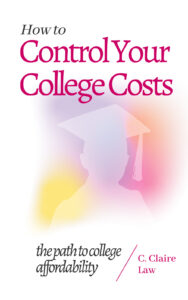Who are the young winners and losers in the $2 trillion stimulus package, called the Coronavirus Aid, Relief, and Economic Security (CARES) Act, passed on March 27, 2020?
The winners
Parents with children under the age of 17 who claimed their children as dependents on their latest tax return. They received $500 per child, in addition to the $2,400 for married couples with less than $150,000 adjusted gross income (AGI) or $1,200 for singles making less than $75,000 AGI.
The losers
Parents with children over 17 years of age. Young adults, ages 17 to 24, do not get this $500 bonus (vox.com/the-goods/2020/4/15/21222170/stimuluschecks-dependents-excluded). They seem disproportionately affected because they may be the ones needing it the most. If they live off campus, they are still paying rent, or may have had to buy a last-minute flight home amidst other fixed expenses. Colleges are moving to reimburse student fees and meal plans. However, one of my clients voiced disappointment over the remaining high cost he’s still paying, at an institution known to have a large endowment, while his son is sitting at the kitchen table. A $500 bonus for the 17 to 24 years cohort would have been nice.
Good news for borrowers
Payments on federal loans or any loans owned by the Department of Education are paused and the interest rate is zero, for six months: from March 13 to September 30, 2020 (studentloanborrowerassistance.org/what-the-cares-act-means-for-repayment-of-federal-student-loans). This payment pause and interest waiver means it freezes the loans with no new interest charged and no payments required until September 30, 2020. The balance owed at the end of September will be the same as it is today. Auto debit payments are also suspended. Borrowers can make payments if they wish, which will go entirely to principal. If you’ve made a payment after March 13 you can ask your servicer to send it back to you. There’s no benefit to continue paying your loans if the CARES Act makes it look like you made the six on-time payments. Save your money and pay down your principal balance after September 30, 2020.
More news for borrowers
The Department of Education will pay the interest on loans for borrowers still in college and those who placed their loans in deferment or forbearance. However, it’s still unclear how this will affect future interest capitalization. Undergraduates with Federal Direct loans and graduate students with PLUS loans should keep checking their account with their servicers and on the National Student Loan Data System (NSLDS). They can access NSLDS through the studentaid.gov website and their Federal Student Aid ID (Source: The Institute for College Access & Success). Student borrowers should continue to check studentaid.gov/announcements-events/coronavirus for updates.
Unfortunately, those who still have FFELP loans lose out. Under the Family Federal Education Loan Program, private lenders took federal funds and made loans to students and parents. There’s no six-month reprieve for these FFEPL borrowers. It’s tragic because the college directed families to their preferred private lenders. In the rush and excitement to pay for college, students and parents didn’t stop and ask the financial aid administrator if they could take the loans from their bank or trust, or from the government. FFELP ended in 2010 but many people are still in repayment. These FFELP loans as well as nursing and Perkins loans are not eligible for the CARES Act six-month payment pause and zero-interest benefit. However, I would call the private lender and ask for some borrower relief. Private lenders are well aware of federal terms, and try to keep their terms competitive, albeit unsuccessfully. Federal loans are better.
Good news for Public Service Loan Forgiveness (PSLF) applicants
They will receive six months of payment and interest suspension which will count as “qualifying payments” toward the 120 on-time payment requirements. In effect, they will need to make only 114 payments. Ironically, if they lose their job, then the paused payments won’t count toward the loan forgiveness. But as long as these borrowers remain employed, remember to recertify every year, and work for an employer who qualifies as non-profit, this could be a winner!


